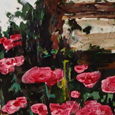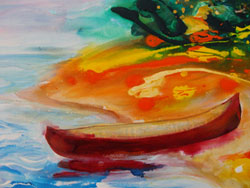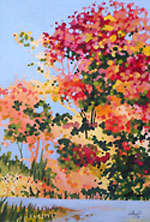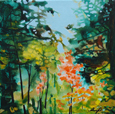There are some similarities between a glazed painting and a glazed donut. The painting definition for glazing is ‘a transparent colour placed ontop of a previously dry colour, so that the previous colour shows through.’ This effect of transparent layering of colour can give beautiful subtle shifts in colour. The light traveling through those layers does indeed give a different effect than just mixing that colour to start with. It’s most challenging with watercolour. For best effect in watercolour, make sure that the paint is completely dry, and use a quick light touch to apply the next colour. You may be surprised how little the first colour moves if you do this quickly, because it takes a few seconds for the first colour to reactivate with water. Sedimentary colours, which sit up on the surface, make this more difficult than working with staining colours. If you aren’t sure which is which, a good quality artist colour will tell you on the tube. However the best thing is always trial and error – that’s how most of us learn. And donuts? Well, with a sugar glaze on a chocolate donut, the colour of the chocolate does show through. Conclusion: the main difference between a glazed painting, and a glazed donut is … calories.






